Please scroll to the bottom of the page for the English version.
- 日本が誇る伝統文化「盆栽/BONSAI」
- 東京での「TRADMAN’S BONSAI」との出会いとバンクーバーで見かける「BONSAI」
- 「TRADMAN’S GALLERY」に足を踏み入れると広がる絶景
- 「TRADMAN’S BONSAI」創立までのヒストリー
- ジョセフから鉄平さんと修介さんへの一問一答
- 日本を明るい未来へ導く盆栽の力
- かっこいい日本の伝統文化BONSAIを通して、日本をひっくり返す
- ジャーナリスト、ライターの仕事のご依頼はこちらのフォームから
- The traditional Japanese art of bonsai
- Encounter with “TRADMAN’S BONSAI” in Tokyo and Spotting “BONSAI” in Vancouver
- Stepping into the “TRADMAN’S GALLERY” reveals a breathtaking view
- The History Leading Up to the Establishment of “TRADMAN’S BONSAI”
- Q&A with Teppei and Shusuke from Joseph
- The power of bonsai guiding Japan towards a brighter future
- Flipping Japan through the cool traditional culture of Bonsai
- For job inquiries, please contact me here
日本が誇る伝統文化「盆栽/BONSAI」
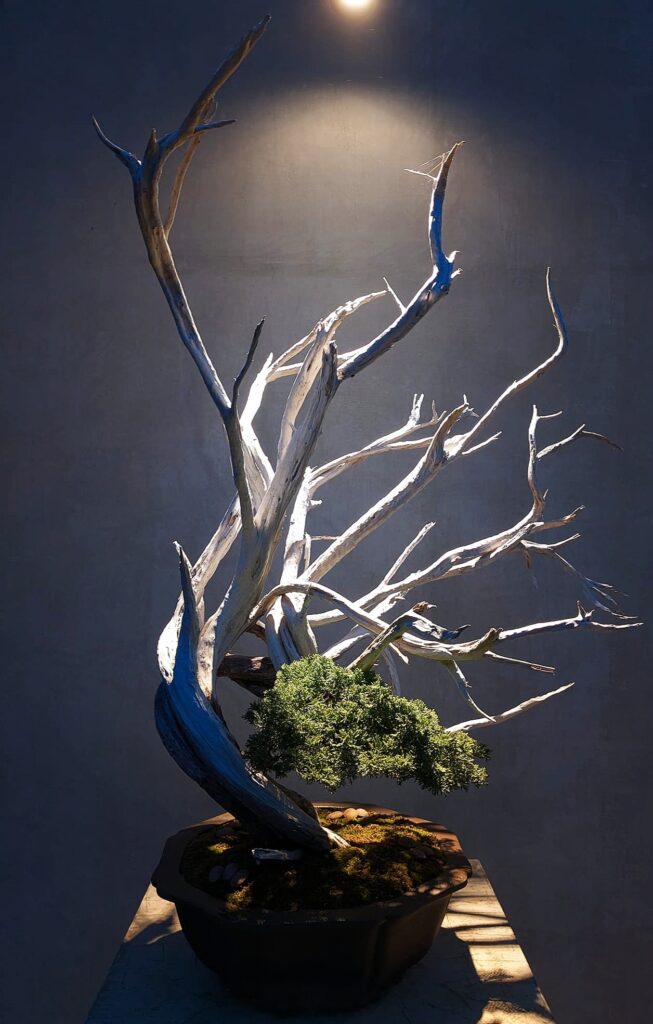
皆さんは「盆栽」と聞いて、まず何を思い浮かべますか?
日本人の中にはまだ「お年寄りが老後に楽しむ趣味」というイメージを持つ人も少なからずいると思います。
しかし近年、盆栽への注目度が増し、日本の若い世代や世界中人々から人気を集めていることをご存知でしょうか?
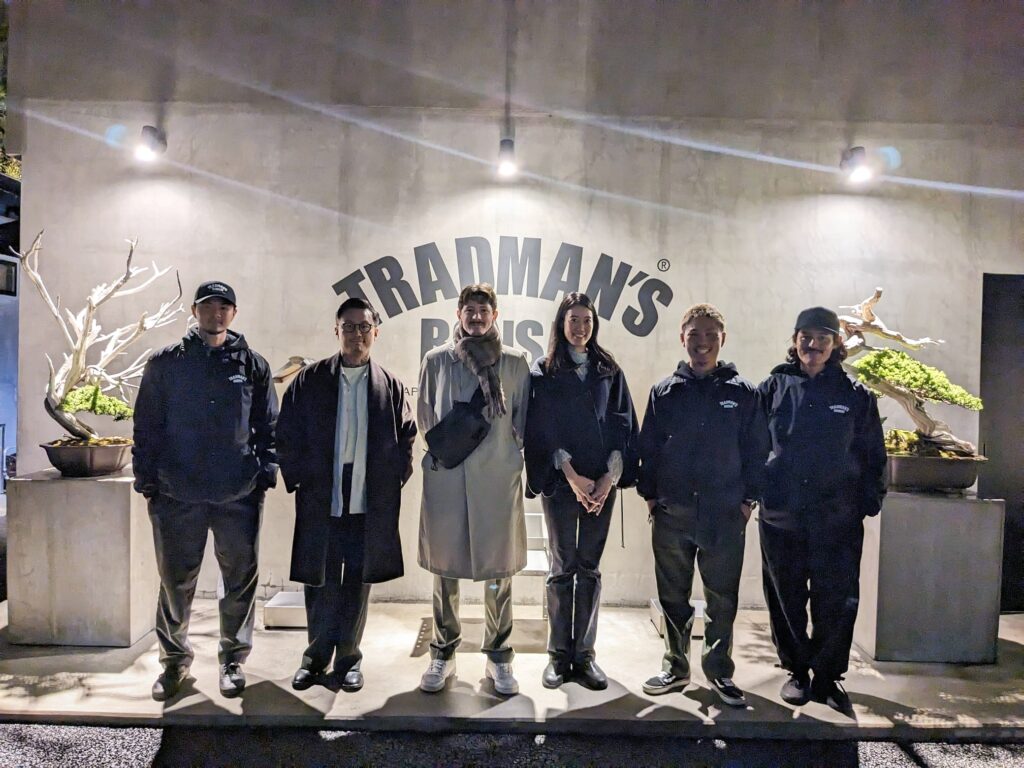
その仕掛け役となっているのが盆栽プロデューサー小島鉄平さんが率いる「TRADMAN’S BOSAI」チーム。こちらの写真のかっこいい日本男児たち。(この日は全メンバーいたわけではないので、他にもメンバーがいらっしゃいます)
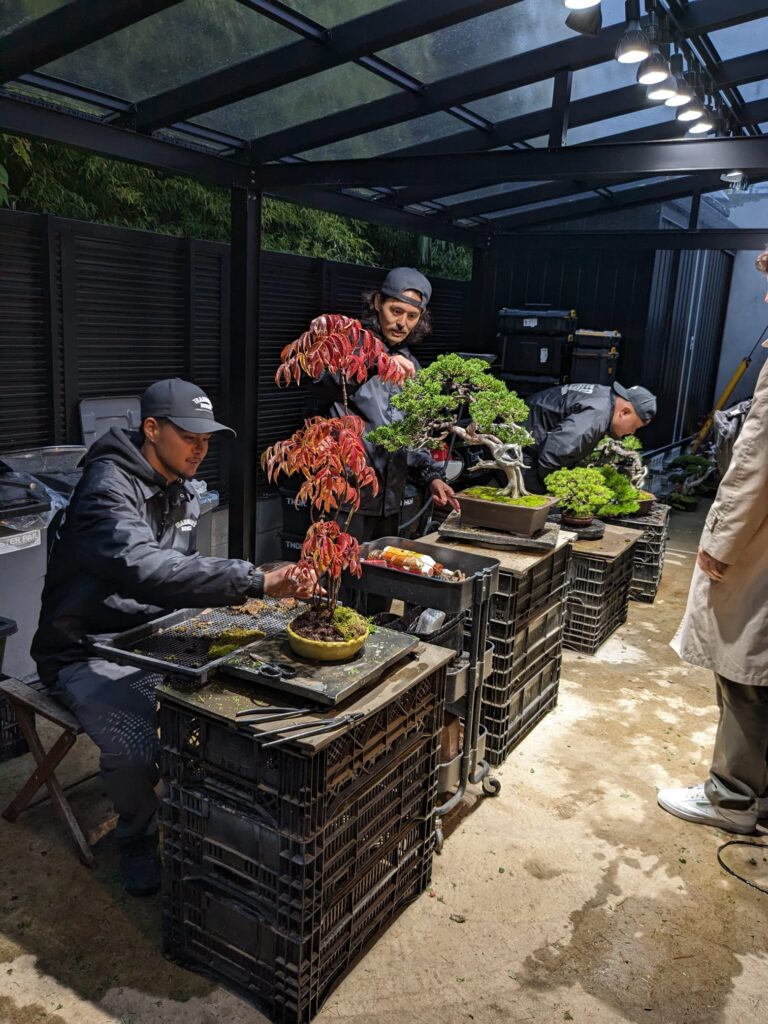

2015年TRADMAN’S BOSAI(株式会社松葉屋)として創立。日本の長い歴史で培われてきた盆栽文化の価値を広めるというミッションを掲げ、 店舗やオフィス、個人宅への盆栽リースから、アパレルセレクトショップやラグジュアリーホテルでの盆栽ディスプレイ、国内外の有名なブランドとのコラボレーションなどをしています。盆栽業界の垣根を超えた色々なジャンルと盆栽を組み合わせることで、新たな盆栽の魅力を世界中に発信しています。
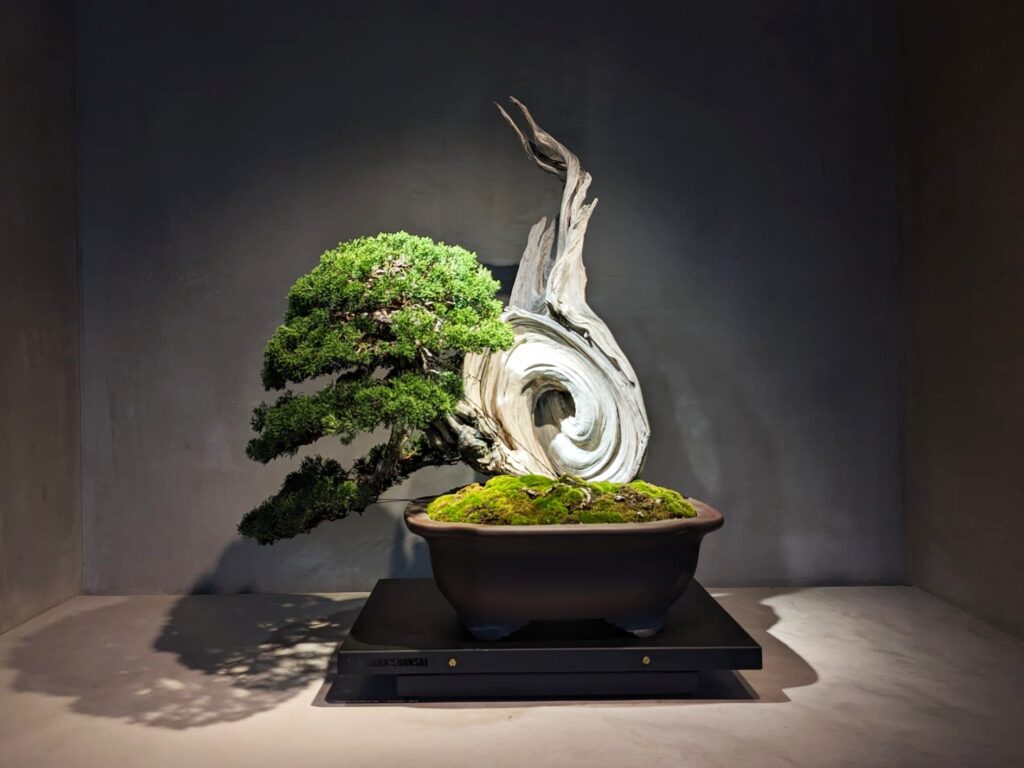
東京での「TRADMAN’S BONSAI」との出会いとバンクーバーで見かける「BONSAI」
私が「TRADMAN’S BONSAI」を知ったのは約10年前の創立当初。日本での元職場が彼らから盆栽をリースしてディスプレイしていました。新しい盆栽が交換される毎週水曜日が楽しみでしょうがなかったです。海外のお客様も多かったので彼らが感動して、目を奪われる瞬間を何度も目にしました。その度に日本の文化を誇らしく感じ、私も盆栽の虜になっていきました。
約2年前にその職場から去り、バンクーバーでの生活を始めた私。バンクーバーで見る「BONSAI」と記載された植物は私の知っている盆栽とは全く異なりました。「え?これがBONSAI?」と思わず独り言を口にしたほど。
本物の盆栽を直で見る機会を失い、日本で扱われている盆栽の価値を再確認した私はパートナージョセフを連れて、2023年11月の一時帰国の際に一般公開されていない「TRADMAN’S BONSAI」のギャラリーにお邪魔することに。そして創立者である代表取締役小島鉄平さんと副社長小山修介さんにインタビューの時間をいただきました。
「TRADMAN’S GALLERY」に足を踏み入れると広がる絶景
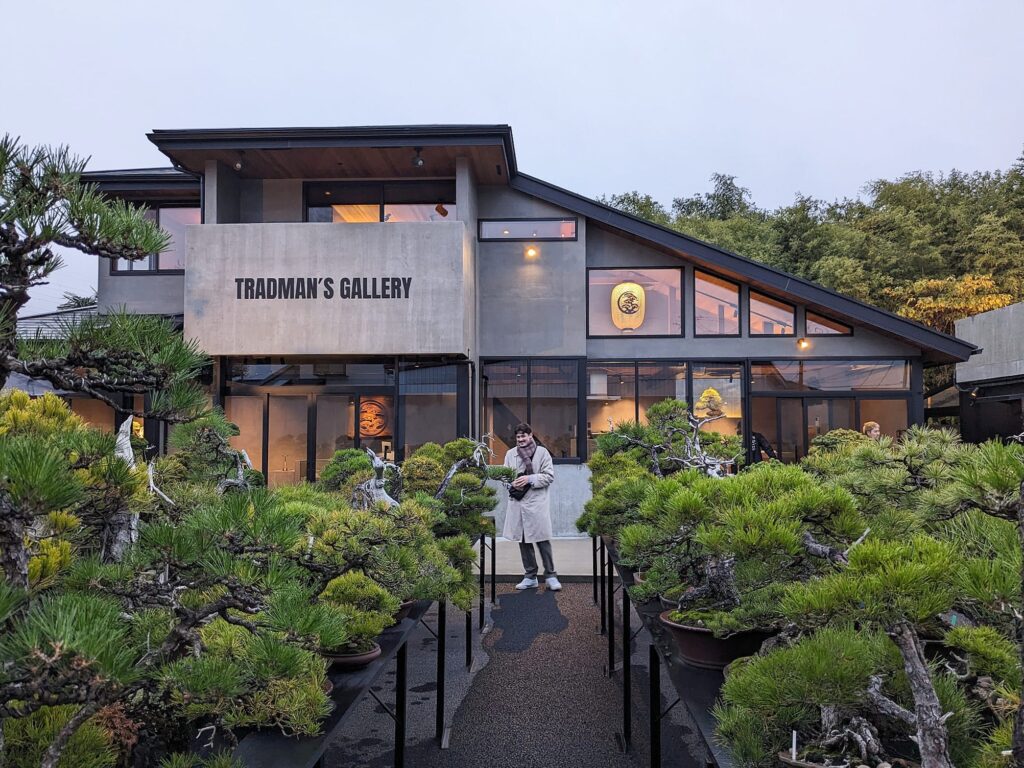
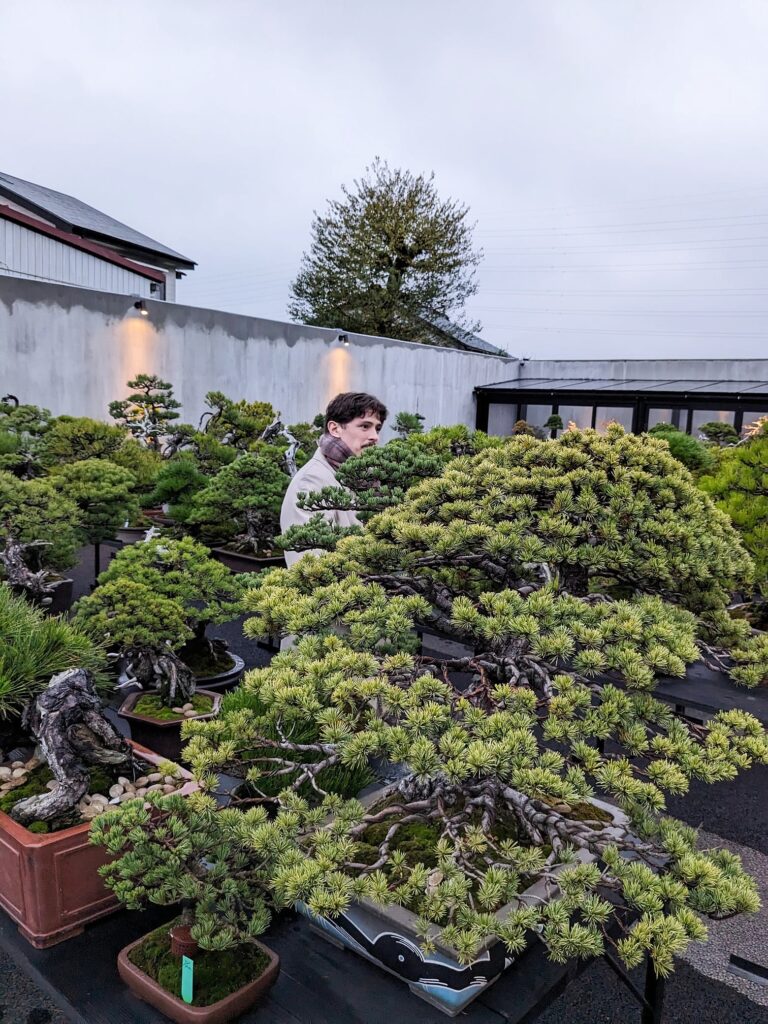
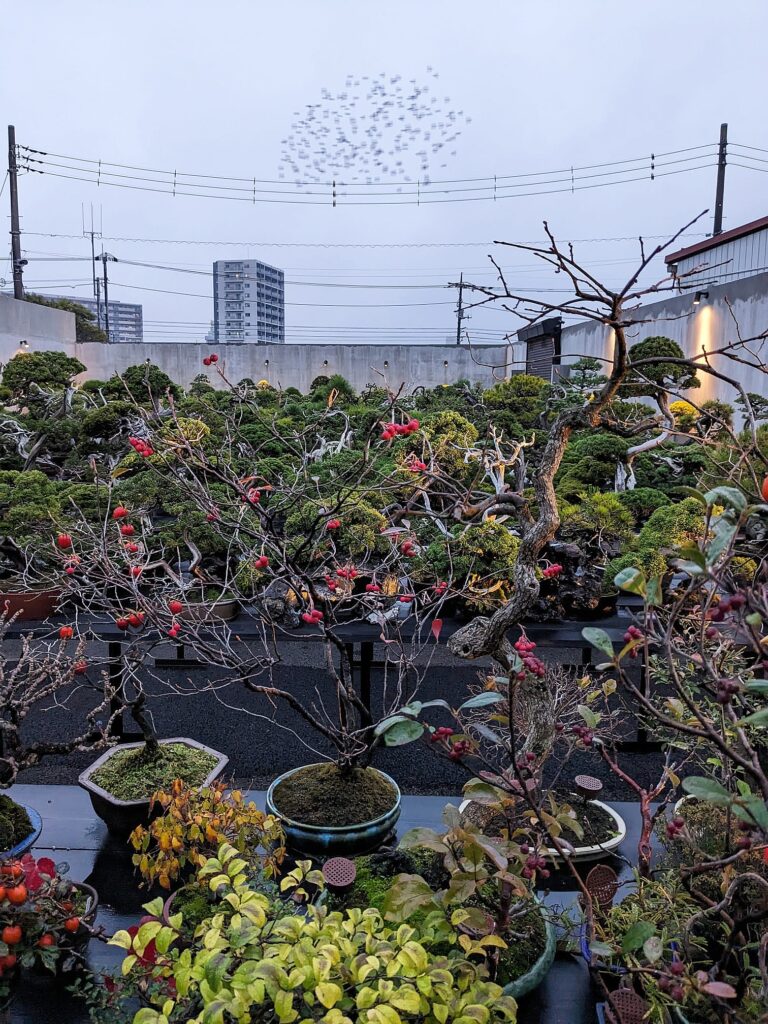
私がバンクーバーに行ってしばらくしてから完成したこちらのギャラリーにお邪魔するのを帰国前から楽しみにしていました。入った瞬間に500鉢以上の盆栽が美しく並ぶ圧巻の風景が広がり、開いた口が塞がりませんでした。
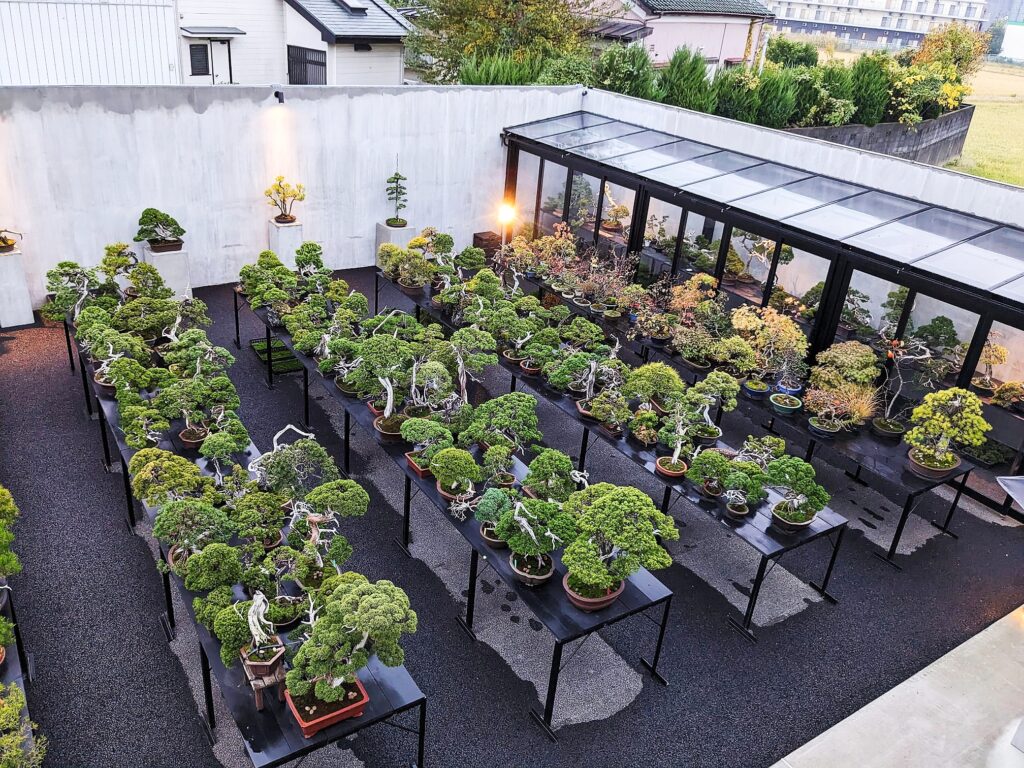
ギャラリーの二階に登ると、こちらの写真のように全ての盆栽が一望できます。晴れた日は富士山が見えるそう。設計は全て鉄平さんが行ったそうです。この二階から見る土地を全てギャラリーの敷地にしてどんどん大きくしてきたいと彼は語ります。
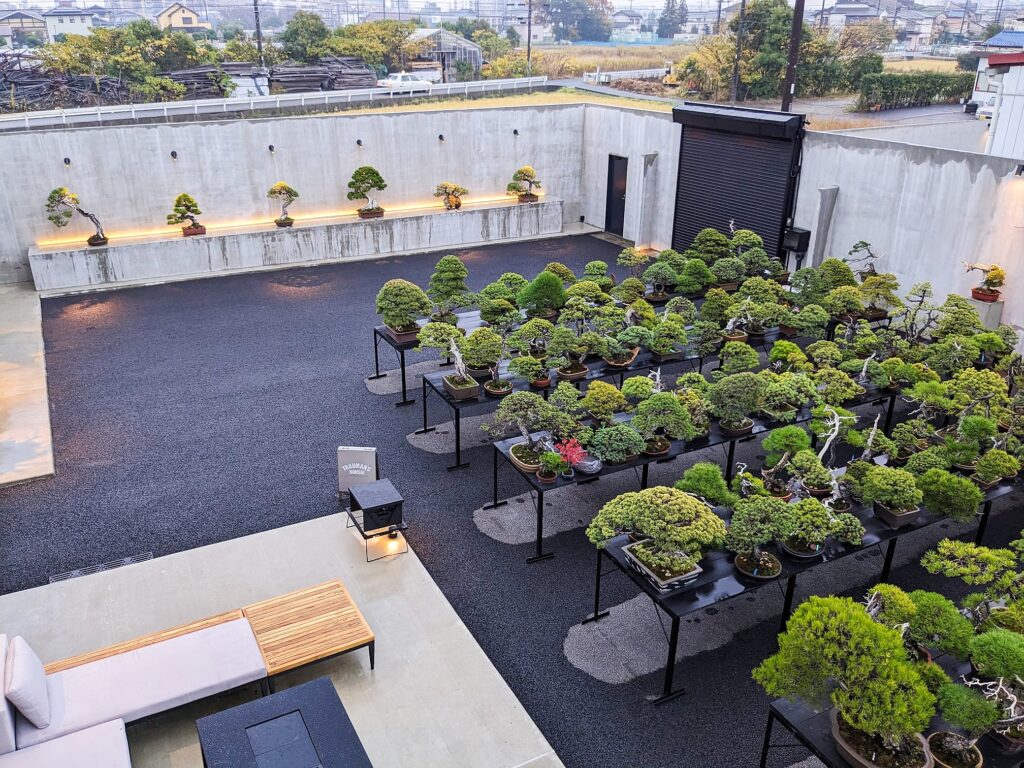
「TRADMAN’S BONSAI」創立までのヒストリー
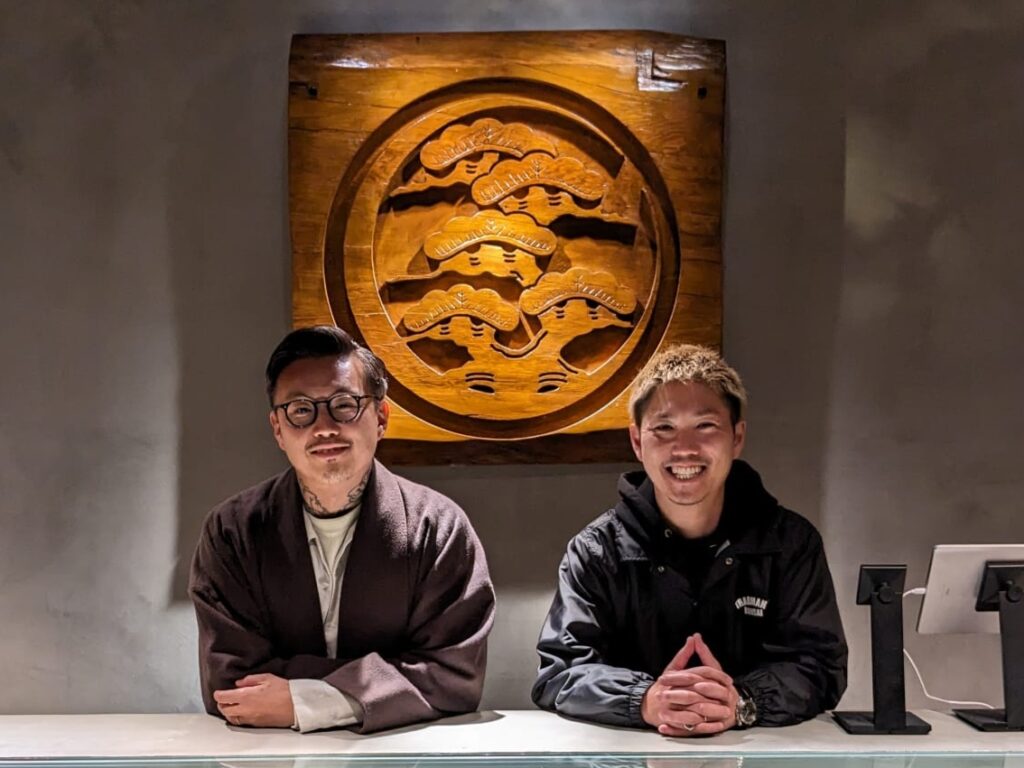
代表取締役小島鉄平さん(写真左)と副社長小山修介さん(写真右)にまずお聞きしたのが「TRADMAN’S BONSAI」創立までのヒストリーです。
私:盆栽を始めたきっかけはなんですか?
鉄平さん:幼少期の頃に親に一時的なトラブルがあって僕らを育てられなくなってしまって。僕、数年間施設で育ったんですよ。そこの園長先生が盆栽を触って並べていたのを見ていたんです。そこでなんとなく盆栽を知って、触ったりしていたのが元々の始まりです。
だから僕の中では、その時から心のどこかに盆栽があったんですよね。
私:施設で育った頃は何歳ぐらいでしたか?
鉄平さん:幼稚園から小学校一年生か二年生の頃。その後親に引き取られて引っ越しました。その先が千葉県の柏市松葉町。松葉小学校、松葉中学校に行って。「松の葉」という名前が自分の周りに常にありました。だから会社を立ち上げた時に「株式会社松葉屋」という名前に決めました。
ちなみに修介(のちにTRADMAN’S 副社長となる)とも松葉小学校で出会いました。
私:TRADMAN’Sを始める前に、鉄平さんは古着のビジネスをされていましたよね?それが盆栽のビジネスに繋がったとお聞きしています。その背景を詳しく聞かせていただけますか?
鉄平さん:小学校5年生の時に親父からヴィンテージを教えてもらったのが一番最初です。特にリーバイスのヴィンテージ。古着って元々は数千円だったものが、時間が経って色んな人が履いて汚くなってるのに何十万円にもなるのは何故なのか、時代背景を凄く勉強して。履いた人の背景が色落ちに出るとか、そういう部分にすごい痺れちゃったんですよね。
そんな幼少期を経て、大人になったら洋服屋さんをやりたいなと思ったんですよ。そこに行き着くまでに色々なストリートカルチャーや音楽などに囲まれて年を重ねました。そして実際に大人になって洋服屋さんをやることになりました。
私:古着から盆栽に移行したきっかけはなんですか?
鉄平さん:当時はバイヤーとして古着を見に行くために、色々な国を周っていました。そこに飾ってあった盆栽があまりにも格好良くなくて、自分の知っている盆栽とはかけ離れたものが「Bonsai」呼ばれていることに違和感がありました。
その時に海外の人に「これが本当の盆栽だよ」と写真を見せた時のリアクションを見て、これは何かできるのではと思ったのが最初のきっかけですね。
盆栽もなんとなく知ってたし、盆栽をやっている人間が自分の周りにもいたし。これはなんか新しい表現で本当の盆栽を世界に伝えることができるんじゃないかと思いました。そして、日本に戻ってTRADMAN’Sのチームを作りました。
私:そのアイディアを思いついてからTRASMAN’Sのチーム結成に至った期間ってどれぐらいでしたか?
鉄平さん: 1ヶ月以内ですね。
私:結構大きい挑戦ですよね。周りの人たちの反応はどうでしたか?
鉄平さん:周りの人たちは、結構普通でしたね。僕が昔からそういうタイプなので驚かなかったです。みんな応援してくれたし。そしてこれからのTRADMAN’Sの将来像ににめちゃくちゃ自信があったんですよ。
いち盆栽屋さんではなくて、元々のストリートカルチャーの背景があって、それと盆栽のミックスがTRADMAN’Sなので。それはどこもやってなかったから。盆栽業界だけの話になると、完全にレッドオーシャン。もうみんなやり切ってるんですよ。でも自分らがやろうとしてることはブルーオーシャンで何でも表現できるなと思ったんです。
ジョセフ:始めた当初の規模感ってどれくらいでしたか?何個の盆栽を取り扱っていましたか?
鉄平さん:盆栽のセレクトショップの棚を借りて、そこで自分たちの盆栽を販売したのがスタートです。当初は20か30個の盆栽から始まりました。
ジョセフ:オークションに参加してこれらの盆栽を集めているんですよね?
修介さん:はい。ただオークションも色んな段階があって、下積みを積んでやっと今の最上級オークションにいけるようになりました。今僕らが参加させてもらっているものは、世間的に良い盆栽が集まるといわれるオークションです。
ジョセフ:創立当初の一番大きいリスクは何でしたか?
鉄平さん:すぐ売れるわけじゃなかったから、貯金を使ったぐらいかな。資本金は1000万円くらいでしたよ。22か23歳の時から色んな会社経営やブランディングをしていて、そのビジネスを全て販売して、TRADMAN’Sの資本金を作って始めたんです。
ただ絶対的な自信がありましたね。
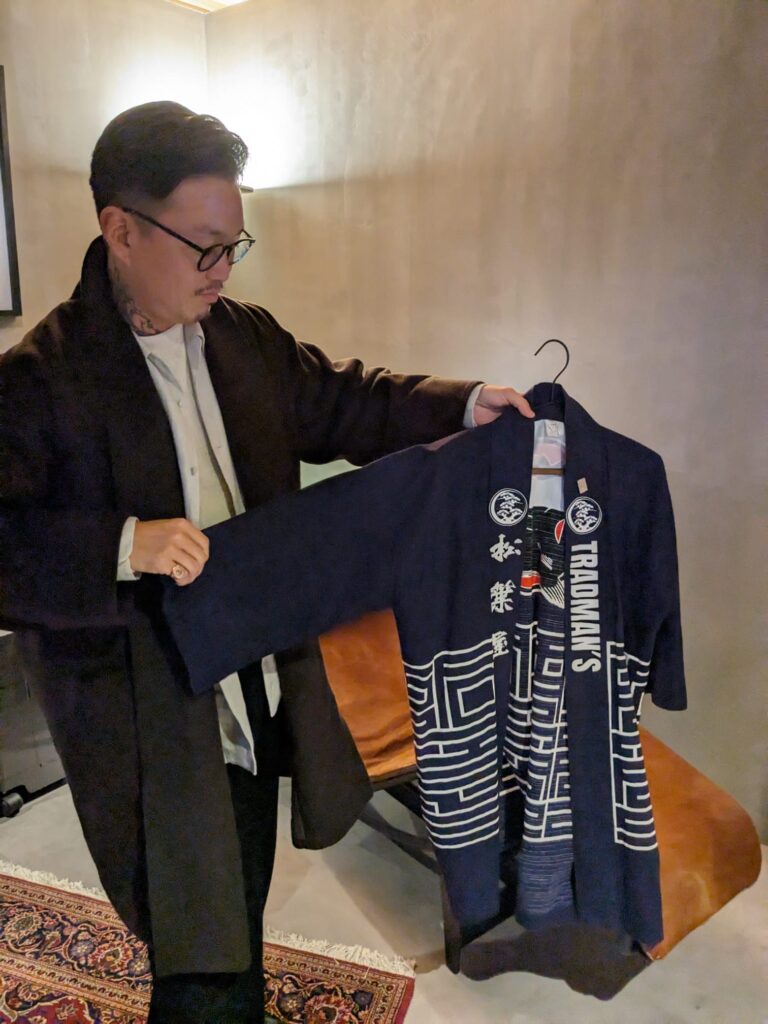

仲間との喧嘩別れが、盆栽の師匠の元へ弟子入りするきっかけに
私:その自信が一度もブレたことはないですか?
鉄平さん:実は一度だけスランプがあったんです。約10年前に一緒にやっていた人間と考え方の相違から喧嘩別れした時ですね。
彼は盆栽作家だったので、作家がいなくなることでやる気がなくなってしまって。その時に修介(副社長)には本当に支えられました。
ただそれをきっかけに自分たちでしっかりと盆栽を学ようになりました。修介と2人で盆栽の先生のところに修行にもいって。逆にそれがなかったら盆栽をちゃんと触ってなかったかもしれないです。
今振り返ると、いい機会を与えてもらえたなと思います。
私:ストリートカルチャーと盆栽をミックスすることへの師匠の反応は?
作家と喧嘩別れして、すぐに技術が身に付けられるわけじゃないじゃないですか。ただ僕の師匠はとても柔軟性のある人なんですよ。
僕らのやっていることを師匠に話して協力をお願いしました。彼も初代で紆余曲折があった過去があるので理解してくれて。そして技術をしっかり学ばなければと思って、師匠の下で修行を始めました。
盆栽業界って実は修行するとなると、丸々5年間給料なしで住み込みで、師匠に捧げるのが普通なんです。ただ僕らは会社を立ち上げていたし、家族もいるし通うことしかできない。師匠もそれを受け入れてくれました。
ただ僕らが盆栽園に出入りしてると、タトゥーだらけの怖い人たちがきたって感じで噂にはなりましたね。
私:師匠のとこに通っていたのはどれくらい期間ですか?
実はめちゃくちゃ早くて2年間でした。本当だったら5年くらいなんですけど、僕たちの会社がどんどん成長して忙しくなって、通えなくなってしまって。師匠に話したんですよ。「僕ちょっと、、、みたいな。笑」
そしたら師匠が「最低限のことは出来るようになってるし、もう大丈夫。あとは任せろ」と言ってくれたんです。
そして修行の卒業と同時に、僕は師匠に「社員になってください!」って話したんです。それで今師匠はTRADMAN’Sの社員になりました!
私:え? 師匠柔軟性ありすぎません?
鉄平さん:そう。師匠は僕の部下であり、僕は弟子であり社長なんです。複雑な関係なんですよ。笑
正直修行の2年間は精神的にやられましたね。しょっちゅう怒鳴られて、怒られて、本当に厳しかったです。今思うと良い経験ですけど。当時俺ら病んでたもんな。(修介さんと顔を見合わせて笑うお二人)
その時は師匠とめちゃくちゃ喧嘩もしたし。それを経て今は本当に良い関係を築かせてもらってます。
ジョセフから鉄平さんと修介さんへの一問一答
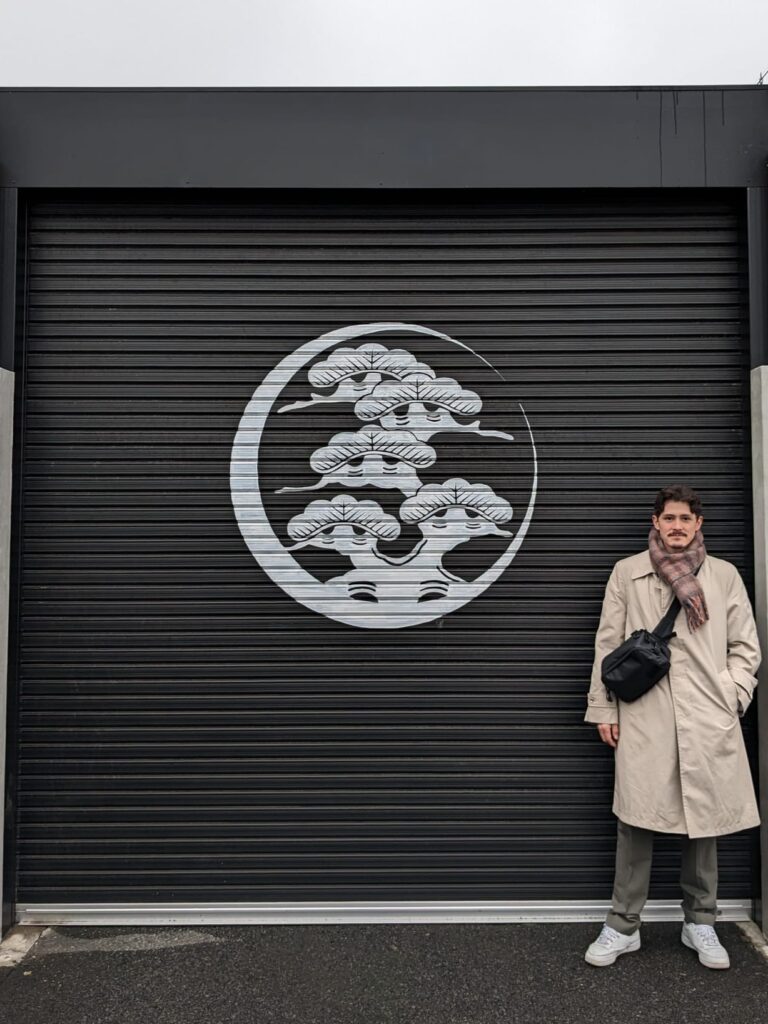
ジョセフ:お二人は松葉小学校で出会ったということですが、TRADMAN’S創立時に鉄平さんが修介さんに声をかけたんですか?
鉄平さん:はい。元々色んな仕事を一緒にやっていて。一緒に住んでた時期もあったし。
ジョセフ:何で修介さんは、Yesって言ったんですか?
修介さん:昔から色々一緒に仕事をしていて、僕にとってはとても自然なことでした。
ジョセフ:盆栽に元々興味がありましたか?それか鉄平さんとやり始めてから盆栽に興味を抱き始めましたか?
修介さん:後者の方です!
ジョセフ:仕事の中で特に自分の好きな部分って何ですか?
鉄平さん:自分が盆栽を世界に伝えることです。それが日本を変えることに繋がると思っているので。
修介さん:たくさんのクライアントさんに盆栽を広められているという実感ができる瞬間一番嬉しいし、やりがいがありますね。
ジョセフ:一番好きな盆栽教えてもらえますか?
鉄平さん:僕はずっと変わらず「501」っていう初めて自分で高い値段を出して買った盆栽です。世の中的には良い盆栽ではないんですけど、色んな気持ちが詰まっている大切で特別な盆栽です。
修介さん:僕は黒松っていう盆栽があるんですけど、オークションに参加できるようになった当初に初めて落としたものです。その子もすごい良いものっていうわけではないんですけど、落とせたぞ!っていう思い出が詰まっているので。
日本を明るい未来へ導く盆栽の力
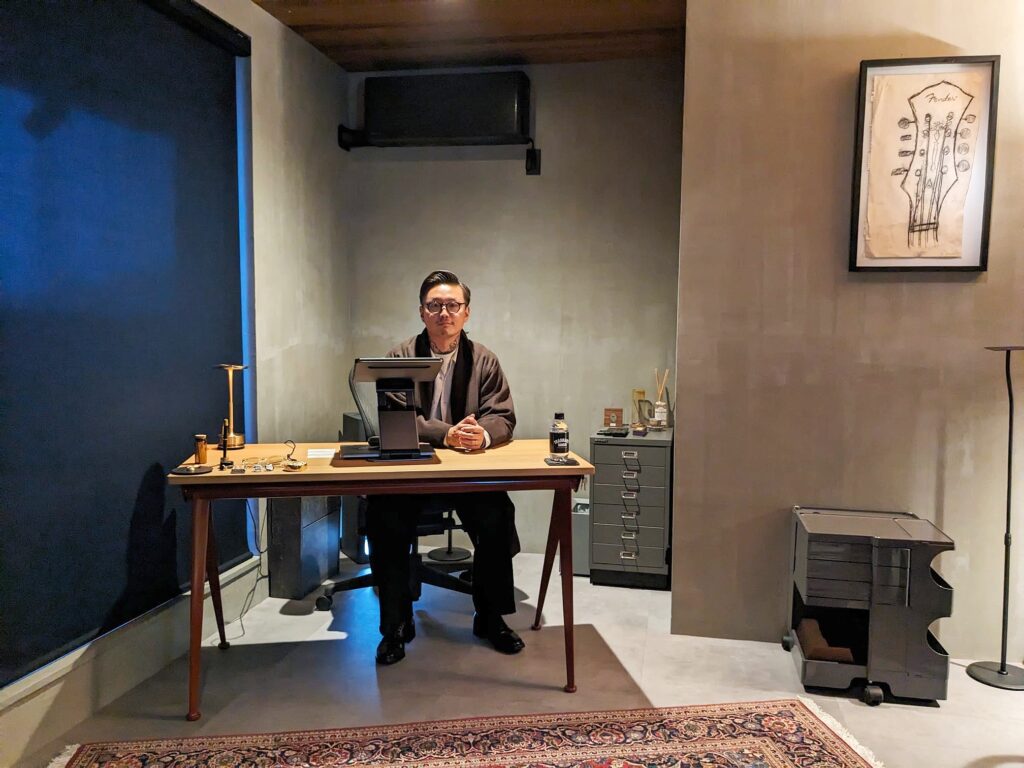
11月の帰国時に久しぶりにTVで日本のニュースを見ました。円安、不安が募る老後、若者に重くのしかかる税金。ネガティブなニュースしか耳に入らず悲しくなりました。
そこで鉄平さんは日本の将来についてどう考えているのかお聞きしました。
世界に誇るかっこいい日本の文化
鉄平さん:僕は最近日本の将来のことばかりずっと考えています。僕たちは日本が戦争に負けて、アメリカのカルチャーが入ってきてその教育を受けてきました。
戦争で負けたからだというのは気付いてなかったんです。でも途中で気づきました。そして僕はリーバイス501のヴィンテージから盆栽の世界へ、そして盆栽から日本の歴史を学びました。
盆栽を知ることで日本の価値のあるものを知っていった。今本気でかっこいいと思っているのは、日本です。
若い世代が日本の文化のかっこよさに気づくことで日本は変わる
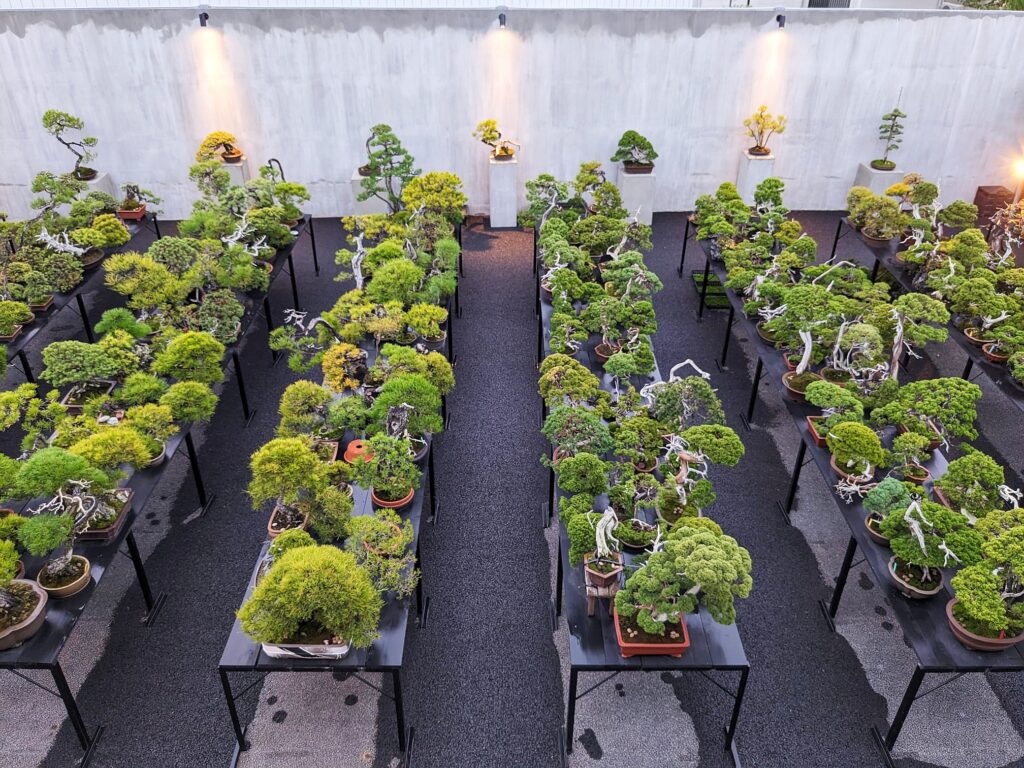
鉄平さん:日本に色んな問題がふりかかっているのは事実です。でもこれをきりかえないといかんですよ。
日本の文化の魅力を世界に発信するのは世界は当たり前です。ただ僕は日本の若い人たちに、日本の文化がかっこいいことをもっと知ってほしい。東京駅、皇居が位置する丸の内に僕たちが店を出そうとしているのは、根本的にその気持ちから来ています。
その店では盆栽だけではなく、色々な伝統文化とコラボレーションするものも販売します。
そこで一人でも多くの人に日本の文化の良さに気づいてほしい。そこで、日本の現状のヤバさに気づいてなんとかしないと思ってほしい。そしてその感情が「選挙に行こう」「選挙に行ったらどうにかなるんじゃないか」とか、そういうアクションに繋がるかもしれない。
僕は若い人たちに日本の良さを知ってもらった時に、日本がひっくり返るんじゃないかと思っています。
日本の将来は暗いという人たちはそっちの世界線に行っちゃう。でも絶対日本は大丈夫、世界は大丈夫と信じていたら、本当にピースな世界で生きれる思っている。
私:今めっちゃ胸高まってます。私は着物が好きだし、ステップマザーの影響もあります。フランス人である彼女から日本の良さをたくさん教わりました。それがバンクーバーにいても、この帰国時もさらに強くなっています。
鉄平さん:日本人の若い子ってそれに気づき始めてる子が実は多いんですよ。特に20代の子が多い。自分たちで調べて頭で考えることができる子が増えてる。メディアの言いなりじゃないんですよ。
若い世代を育てていくことが大事です。僕は確実に体感しています。この若い世代が日本を背負っていける。
求めてればくる!絶対に!ちゃんと目覚めている日本人もたくさんいますよ。
あと日本がやばいと思って日本を出て、海外で色んなことを学んだ結果、日本がさらに好きになって、そして日本を良くしたいと思って活動している人がたくさんいる。
私:とても共感です!まさにそれ私です!!でも時々そんなに日本が好きなら、日本に戻ればって自問自答する時もあります。でも逆にバンクーバーにいるからできることもあるなと思ったり。
鉄平さん:各国に戦士がいて最終的にでっかい元気玉を作ればいいんです。
ちなみに「日本の未来を考える会」という20人くらいの会があって、僕そこに呼ばれたんです。そういうのが水面下にある。ちゃんと考えている人が実はいるんです。
私:でっかい元気玉にバンクーバーから力添えができるように頑張ります。
かっこいい日本の伝統文化BONSAIを通して、日本をひっくり返す
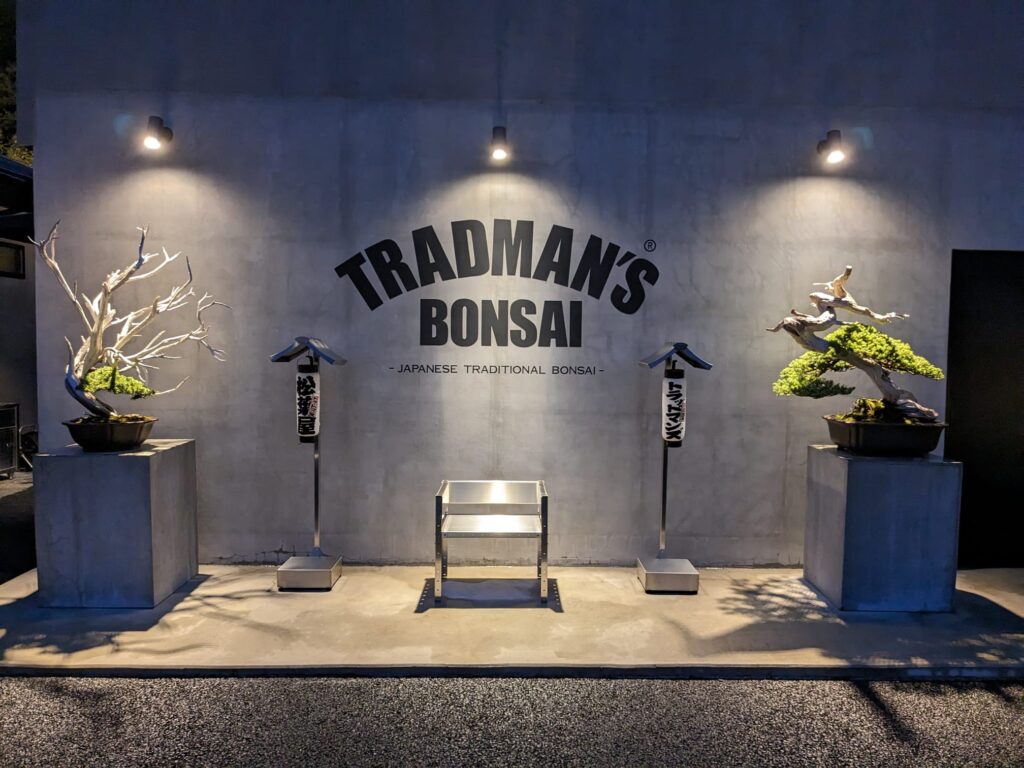
元職場で働いていた頃お二人にお会いしたことは何度かありましたが、改めてお聞きしたことがなかった創立までの歴史や思いを深く知り、TRADMAN’Sが日本はもちろん世界中の人を魅了する理由が改めて分かりました。
そして「日本の未来は明るい。絶対大丈夫」という鉄平さんの言葉を聞いた瞬間に、帰国時に心の中でモヤモヤとしてたものが晴れたように感じました。
「かっこいい日本の伝統文化BONSAIを通して、日本をひっくり返す」TRADMAN’Sの熱い精神を強く感じると同時に心底その理念に共感し、自分が日本人としてすべきことを改めて確認することが出来ました。
ジャーナリストとして記事を発信することで、読んでいただいたひとりでも多くの日本人の方が日本の文化に誇りを持ち、深く理解するきっかけになったらと思います。そして自国を愛する心がさらに芽生えますように。
また海外の方が、日本の文化に興味を持ち、真の魅力と奥深さの虜になるきっかけになりますように。
そしてそれが、失いつつある日本の美しい文化を守る小さな力添えに繋がりますようにという思いで書いています。
「TRADMAN’S BONSAI」のオフィシャルウェブサイトはこちら https://tradmans.jp
ジャーナリスト、ライターの仕事のご依頼はこちらのフォームから
ジャーナリスト、インタビュアーやライターのお仕事のご依頼はこちらから。英語での取材、インタビュー、日英訳ともに必要な記事の執筆も承ります。オンラインで世界中の方々へのインタビューが可能です。
The traditional Japanese art of bonsai
What comes to mind when you hear the word ‘bonsai’?
I believe that among Japanese people, there are still quite a few who associate it with a hobby enjoyed by elderly individuals in their retirement years.
However, are you aware that in recent years, there has been an increasing interest in bonsai, and it has been gaining popularity among the younger generation in Japan and people all over the world?
Leading the charge is bonsai producer Teppei Kojima, who heads the team at “TRADMAN’S BONSAI.” Here are some cool Japanese gentlemen in the photo (though not all members were present on this particular day, as there are others as well).
Founded in 2015 as TRADMAN’S BONSAI (Matabayashi Co., Ltd.), the mission is to spread the value of bonsai culture cultivated over Japan’s long history. They engage in various activities, from leasing bonsai to stores, offices, and private homes, to displaying bonsai in apparel select shops and luxury hotels, as well as collaborating with famous brands both domestically and internationally. By combining bonsai with various genres beyond the boundaries of the bonsai industry, they are promoting the allure of bonsai worldwide.
Encounter with “TRADMAN’S BONSAI” in Tokyo and Spotting “BONSAI” in Vancouver
I first became acquainted with “TRADMAN’S BONSAI” about 10 years ago when they were first established. My former workplace in Japan leased bonsai from them for display. I looked forward to Wednesdays when new bonsai would be exchanged, and I couldn’t wait to see them. Since there were many foreign visitors, I witnessed their amazement and captivation by the bonsai on numerous occasions. Each time, I felt proud of Japanese culture and gradually became enamored with bonsai myself.
About 2 years ago, I left that workplace and started living in Vancouver. The plants labeled as “BONSAI” that I saw in Vancouver were completely different from the bonsai I knew. I couldn’t help but mutter to myself, “Huh? Is this BONSAI?”
Having lost the opportunity to see real bonsai up close, I reaffirmed the value of bonsai handled in Japan. So, during a temporary return to Japan in November 2023 with my partner Joseph, we visited the gallery of “TRADMAN’S BONSAI,” which is not open to the public. There, we had the opportunity to interview the CEO Teppei Kojima, and the vice president, Shusuke Koyama.
Stepping into the “TRADMAN’S GALLERY” reveals a breathtaking view
I had been looking forward to visiting this gallery, which was completed shortly after I arrived in Vancouver. The moment I stepped inside, I was greeted by a breathtaking sight of over 500 bonsai beautifully arranged, leaving me speechless.
Upon ascending to the second floor of the gallery, as shown in this photo, you can oversee all the bonsai. On clear days, Mount Fuji is visible from here. Teppei-san was responsible for all the design work. He expresses his desire to expand the gallery’s premises, utilizing all the land visible from this second floor.
The History Leading Up to the Establishment of “TRADMAN’S BONSAI”
I first asked CEO Teppei Kojima (left in the photo) and Vice President Shusuke Koyama (right in the photo) about the history leading up to the establishment of “TRADMAN’S BONSAI.”
Me: What was the starting point for you to begin bonsai cultivation?
Teppei: When I was young, my parents faced some temporary troubles and couldn’t take care of us anymore. So, I spent a few years in a facility. The headmaster there used to arrange and handle bonsai, and I often saw him working with them. That’s how I got to know bonsai and started interacting with them.
So, in a way, bonsai had always been in my heart since then.
Me: How old were you when you were at the facility?
Teppei: Around kindergarten to first or second grade of elementary school. After that, my parents took me back, and we moved. The place we moved to was Matsuba-cho in Kashiwa City, Chiba Prefecture. I attended Matsuba Elementary School and Matsuba Middle School. The name “Matsu no Ha” (Pine Needle) was always around me. So, when I established the company, I decided to name it “Matsubaya Co., Ltd.”
By the way, I met Shusuke (who later became the vice president of TRADMAN’S) at Matsuba Elementary School.
Me: Before starting TRADMAN’S, you were involved in the vintage clothing business, right? I heard that it somehow led to the bonsai business. Could you please tell us more about the background?
Teppei: The first time I got into vintage was when my dad taught me about it in fifth grade. Especially vintage Levi’s. I studied a lot about the historical background, wondering why something that originally cost a few thousand yen could become worth tens of thousands of yen after being worn and dirtied by various people over time. I was really fascinated by aspects like how the wearer’s background could be reflected in the fading of the color.
After going through such childhood experiences, I thought I would like to run a clothing store when I grew up. Over the years, I was surrounded by various street cultures and music genres. Eventually, I became an adult and started running a clothing store.
Me: What was the catalyst for transitioning from vintage clothing to bonsai?
Teppei: At that time, I traveled to various countries as a buyer to scout for vintage clothing. There, I saw bonsai displayed, but they didn’t look as cool as I expected, and it felt disconnected from the bonsai I was familiar with.
When I showed a picture of real bonsai to foreigners at that time and saw their reactions, I thought there might be something I could do with this.
I had some vague knowledge of bonsai, and there were people around me who practiced bonsai. I thought maybe I could convey real bonsai to the world in a new way. So, when I returned to Japan, I formed the TRADMAN’S team.
Me: How long was it from conceiving that idea to the formation of the TRADMAN’S team?
Teppei: Within a month.
Me: That’s quite a significant challenge. How did people around you react?
Teppei: People around me reacted pretty normally. They weren’t surprised because I’ve always been that type. Everyone supported me. And I had a lot of confidence in the future vision of TRADMAN’S.
It’s not just a bonsai shop; it has its roots in street culture, and the mix of that with bonsai is what TRADMAN’S is all about. That’s something no one else was doing. When it comes to the bonsai industry, it’s a completely red ocean. Everyone’s already doing everything. But what we’re trying to do is in a blue ocean, where we can express anything.
Joseph: What was the scale like when you first started? How many bonsai were you handling?
Teppei: We started by renting shelves at a bonsai select shop and selling our bonsai there. We began with around 20 or 30 bonsai initially.
Joseph: You were gathering these bonsai by participating in auctions, right?
Shusuke: Yes. However, there are various stages in auctions, and it took us a lot of groundwork to finally reach the top-tier auctions we participate in now. What we’re participating in now is considered auctions where high-quality bonsai gather.
Joseph: What was the biggest risk at the inception?
Teppei: Since they didn’t sell right away, I would say using our savings was the biggest risk. Our initial capital was around 10 million yen. I had been involved in various company management and branding since I was 22 or 23 years old, and I sold all those businesses to raise capital for TRADMAN’S.
But I had absolute confidence without a doubt.
The catalyst for becoming an apprentice under a bonsai master was a falling-out with my comrades
Me: Has your confidence ever wavered?
Teppei: Actually, there was only one time when I experienced a slump. It was about 10 years ago when I had a falling-out with someone I was working with due to differences in our perspectives.
He was a bonsai artist, so when the artist left, I lost motivation. That’s when Shusuke (the vice president) really supported me.
However, that incident prompted us to learn bonsai properly on our own. Shusuke and I went to train under a bonsai master. Looking back now, I think it was a good opportunity given to us.
Me: What was your master’s reaction to mixing street culture with bonsai?
When you have a falling-out with an artist and can’t immediately acquire the skills, right? But my master is a very flexible person.
We talked to our master about what we were doing and asked for his cooperation. He understood because he also had a complicated past with his own master. So, we began our apprenticeship under him, believing that we needed to learn the techniques properly.
In the bonsai industry, it’s common to apprentice for a full five years without pay and live with the master. But since we had started a company and had families, and could only visit for training, our master accepted that.
But rumors started circulating when we started frequenting the bonsai garden; it felt like tough, tattooed people were coming in, as if they were intimidating.
Me: How long did you attend your master’s place?
It was actually ridiculously short, only two years. Normally, it would have been about five years, but our company kept growing rapidly and we got too busy to attend regularly. So, I told my master, “I’m kinda… you know, busy. laughs“
Then my master said, “You’ve learned the basics, you’ll be fine. Just leave the rest to me.”
And as soon as I finished my apprenticeship, I said to my master, “Please join us as an employee!” So now my master is an employee of TRADMAN’S!
Me: Huh? Isn’t your master too flexible?
Teppei: Yeah. My master is my subordinate, and I’m his disciple and also the president. It’s a complicated relationship. laughs
To be honest, those two years of training were mentally tough. I was constantly scolded, yelled at; it was really strict. Looking back, it was a good experience, but at the time, we were really struggling. laughs with Shusuke
We had some serious arguments with my master back then. But through that, we’ve built a really good relationship now.
Q&A with Teppei and Shusuke from Joseph
Joseph: You two met at Matsuba Elementary School, but did Teppei approach Shusuke when TRADMAN’S was founded?
Teppei: Yes. We had been working together on various projects originally. There was also a period when we lived together.
Joseph: Why did Shusuke say “Yes”?
Shusuke: We’ve been working together on various projects for a long time, so it felt very natural to me.
Joseph: Were you originally interested in bonsai, or did you become interested after starting with Teppei?
Shusuke: The latter!
Joseph: What is your favorite part of the job?
Teppei: For me, it’s spreading bonsai to the world. I believe it can change Japan.
Shusuke: The most rewarding moment for me is when I feel that we have successfully introduced bonsai to many clients. It gives me a sense of fulfillment.
Joseph: Can you tell me your favorite bonsai?
Teppei: Mine is a bonsai called “501” that I bought for the first time with a high price. It may not be considered a great bonsai by many, but it holds a lot of sentimental value for me.
Shusuke: Mine is a black pine bonsai that I won at auction when I first started participating. It’s not necessarily the best bonsai, but it holds memories of the excitement of winning it.
The power of bonsai guiding Japan towards a brighter future
When I returned to Japan in November, I watched Japanese news on TV for the first time in a while. The yen depreciation, increasing concerns about retirement, and heavy tax burdens on young people were all I heard, and it made me feel sad because of the negative news.
So, I asked Mr. Teppei about his thoughts on Japan’s future.
The cool Japanese culture to be proud of worldwide
Teppei : Lately, I’ve been constantly thinking about the future of Japan. We grew up in Japan after losing the war, with American culture influencing us through education.
I hadn’t realized it was because we lost the war. But I came to that realization along the way. And from vintage Levi’s 501 jeans, I ventured into the world of bonsai, and from bonsai, I learned about Japan’s history.
Through bonsai, I came to understand the valuable aspects of Japan. What I truly believe is cool now is Japan.
Japan will change as the younger generation becomes aware of the coolness of Japanese culture
Teppei: It’s a fact that Japan is facing various problems. But we have to change this.
It’s natural to promote the charm of Japanese culture to the world. However, I want young people in Japan to know more about how cool Japanese culture is. The reason we’re opening a shop in Marunouchi, where Tokyo Station and the Imperial Palace are located, fundamentally stems from that sentiment.
In that shop, we’ll not only sell bonsai but also collaborate with various traditional cultures.
I want as many people as possible to realize the goodness of Japanese culture there. I hope they’ll notice the current dire situation in Japan and think we need to do something about it. And perhaps, that feeling might lead to actions like “Let’s go vote” or “Maybe things will change if we vote.”
I believe when young people learn about the goodness of Japan, Japan might turn around.
Me: I’m feeling really excited right now. I love kimonos, and I’ve been influenced by my stepmother, who is French. I’ve learned a lot about the goodness of Japan from her. Even while in Vancouver, and especially during this recent return trip, that feeling has grown even stronger.
Teppei: You know, many young Japanese are starting to realize that. Especially those in their twenties. There are more kids who can research and think for themselves. They’re not just following what the media says.
It’s important to nurture the younger generation. I’ve experienced it firsthand. This younger generation can carry Japan forward.
If you seek it, it will come!!!! Absolutely!!!! There are many Japanese who are fully awake.
Also, there are many people who think Japan is in trouble, so they leave Japan, learn various things overseas, fall even more in love with Japan, and then work to make Japan better.
Me: I completely resonate with that! That’s exactly how I feel!! But sometimes I question myself, thinking if I love Japan so much, shouldn’t I go back to Japan? But then I also realize there are things I can do precisely because I’m in Vancouver.
Teppei: There are warriors in every country, and ultimately, they should create a huge Genki Dama (Spirit Bomb).
By the way, there’s a group called “The Future of Japan Forum” with about 20 members, and I was invited there. Things like that are happening behind the scenes. There are actually people who are seriously thinking about it.
Me: I’ll do my best to contribute from Vancouver to make that huge Spirit Bomb.
Flipping Japan through the cool traditional culture of Bonsai
I had met both of you a few times during my time at my former workplace, but I had never had the chance to deeply understand the history and thoughts leading up to the establishment until now. Through this conversation, I came to understand once again why TRADMAN’S captivates not only Japan but people all over the world.
And the moment I heard Mr. Tepppei say, “The future of Japan is bright. Absolutely fine,” it felt like the fog in my mind that I had during my return home was lifted.
Feeling the strong spirit of TRADMAN’S, which aims to “flip Japan through the cool traditional culture of BONSAI,” I deeply empathize with its ideology and have reaffirmed what I, as a Japanese, should do.
As a journalist, I hope that by sharing articles, even if it’s just with one more Japanese person, it will become an opportunity for them to take pride in and deeply understand Japanese culture. And may it further cultivate a love for their own country.
Moreover, I hope that it serves as a catalyst for people from other countries to become interested in Japanese culture and become captivated by its true charm and depth.
With this in mind, I write with the hope that it will contribute, even in a small way, to preserving the beautiful culture of Japan that is at risk of being lost.
You can find the official website of “TRADMAN’S BONSAI” here: https://tradmans.jp
For job inquiries, please contact me here
For inquiries regarding jobs as a journalist, interviewer, or writer, please contact me here.
I also accept requests for writing articles that require interviews conducted in English, and translation between Japanese and English. Interviews with people worldwide can be conducted online.
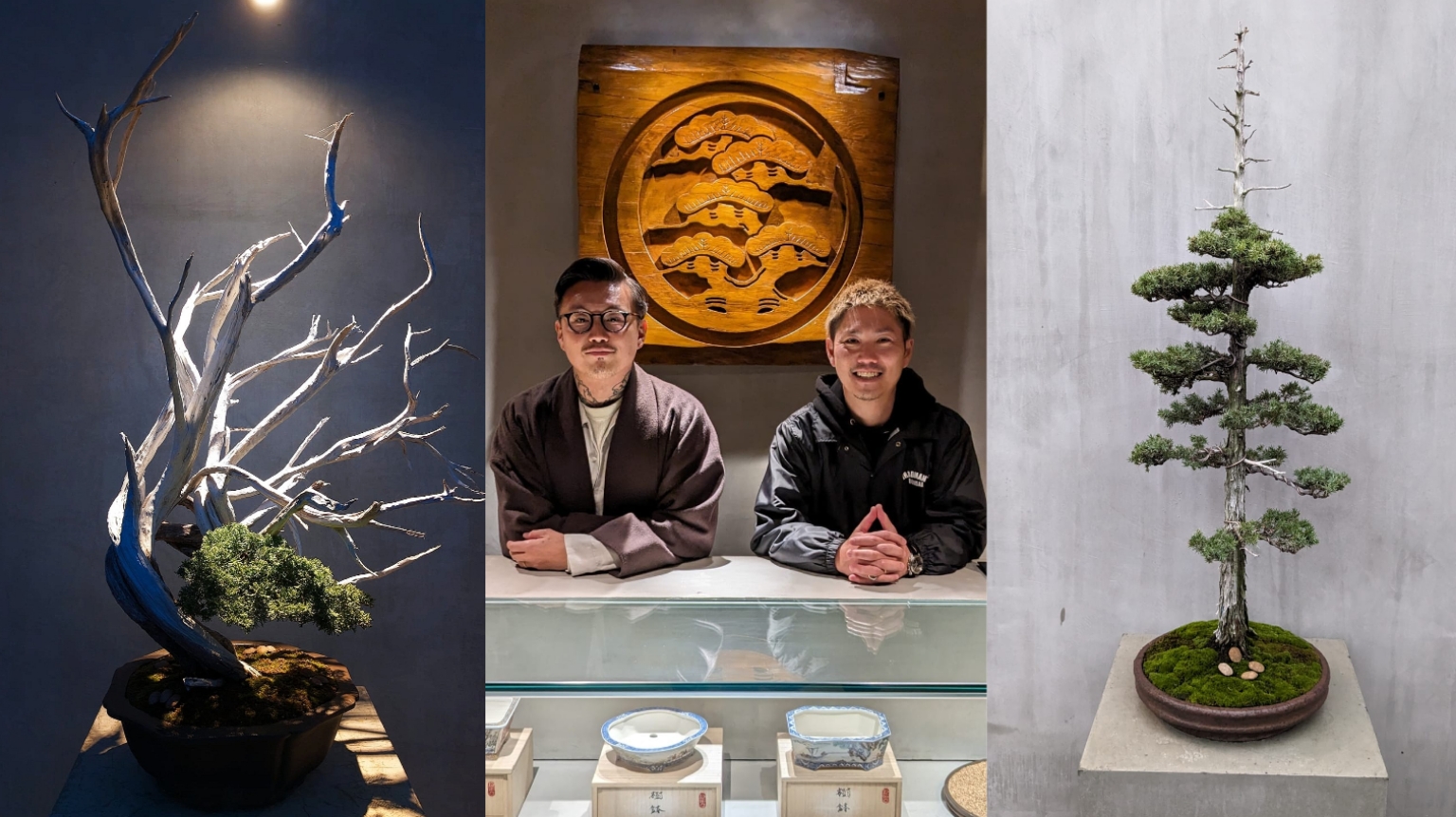
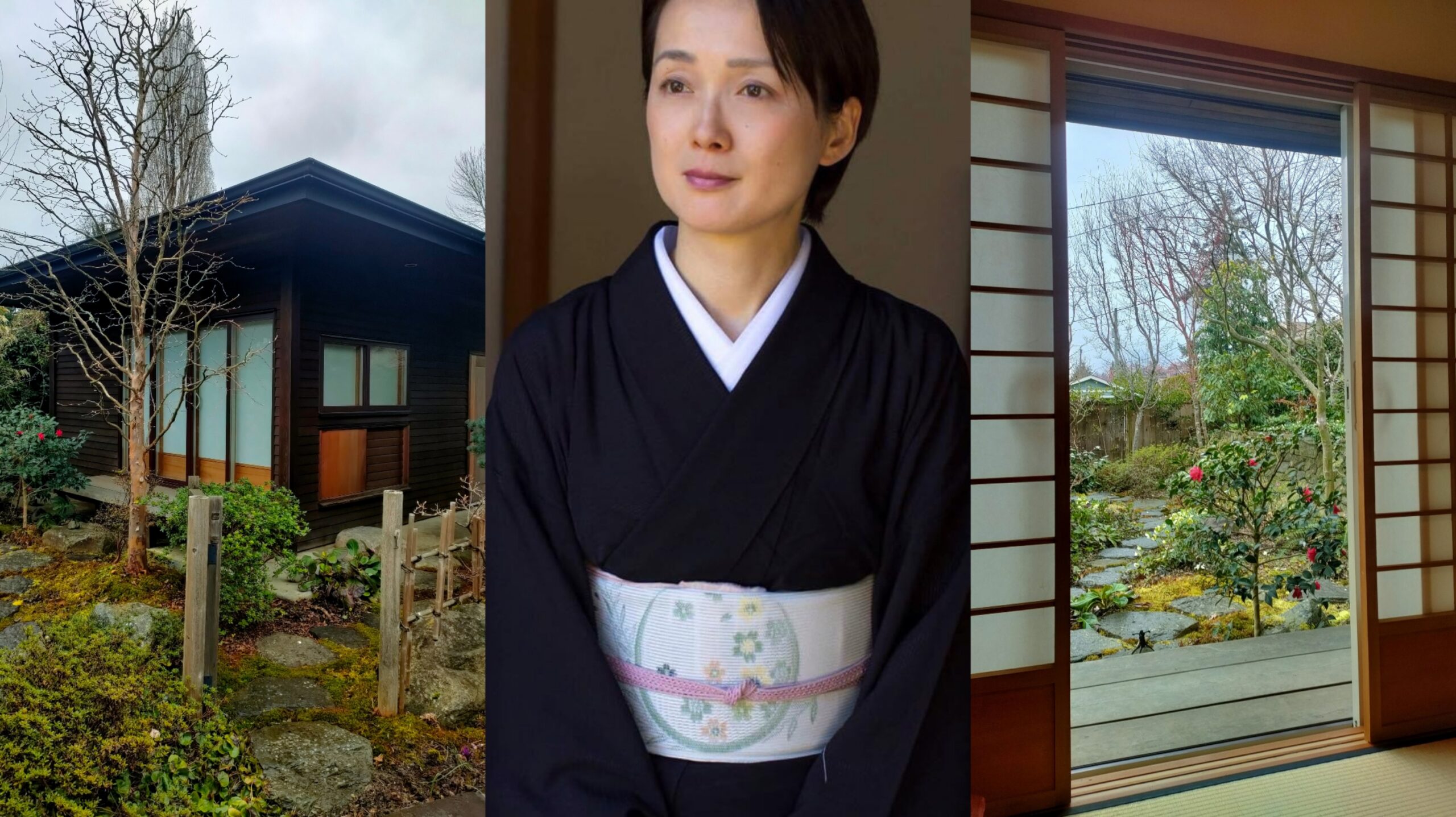
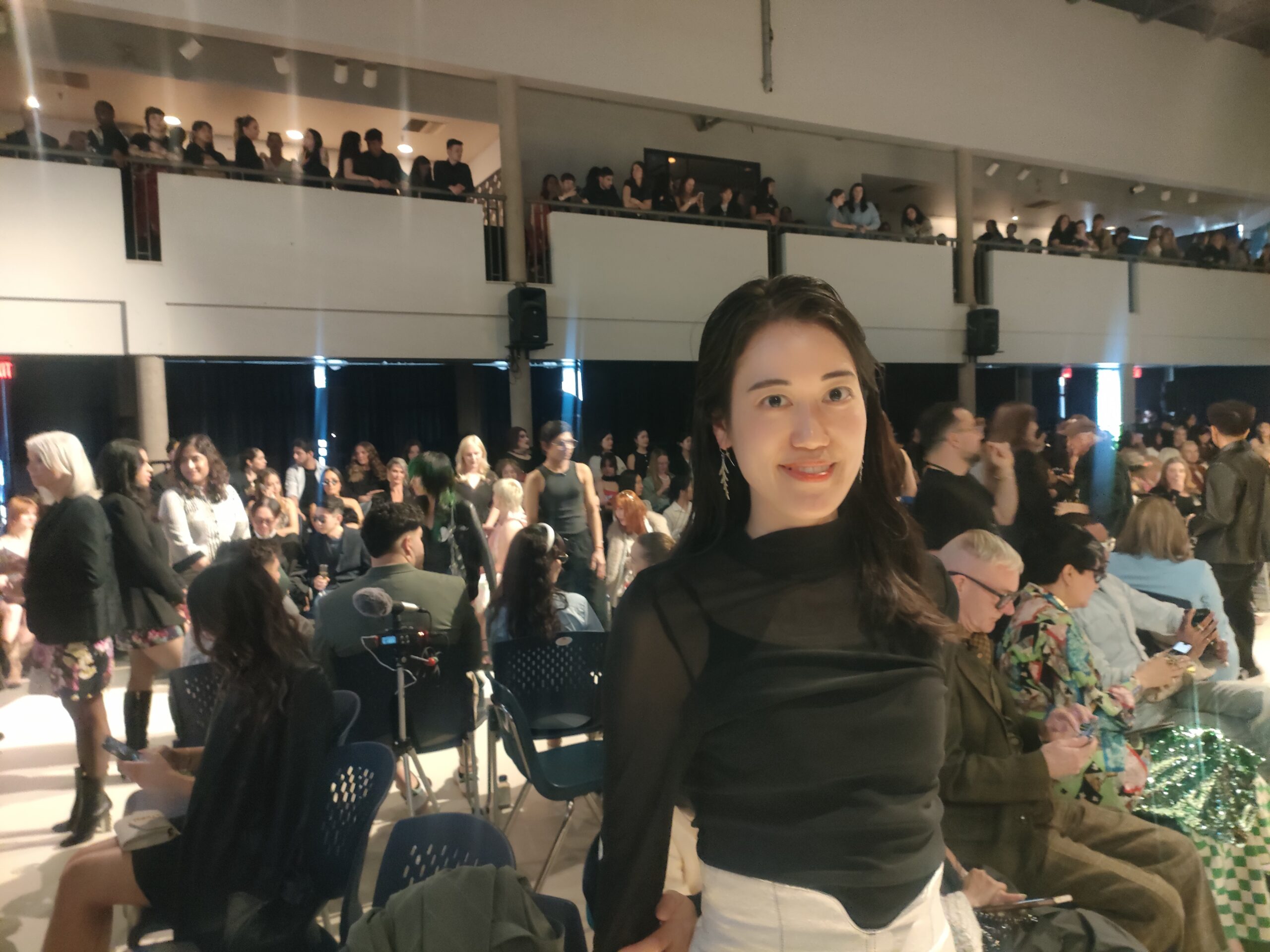
コメント